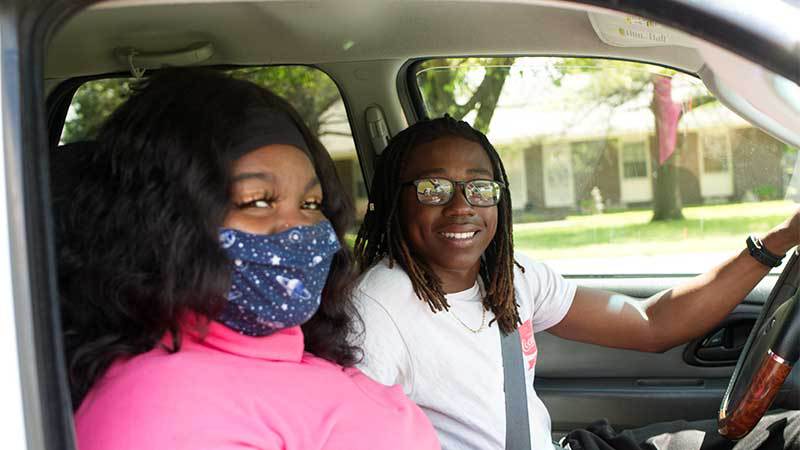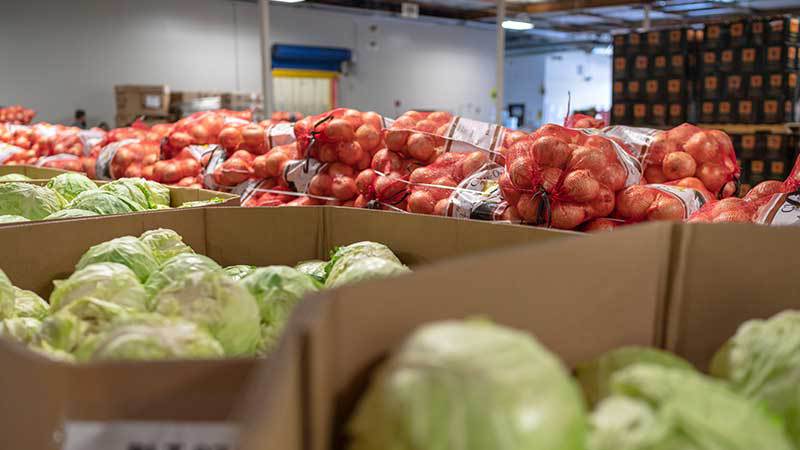MFB’s Evolution for Maryland’s Recovery

The complex issue of hunger existed long before COVID-19.
For years, Marylanders have made tough decisions around their basic needs, often wondering how to feed their families and keep pace with rising costs. And at a time when hundreds of thousands of families were already struggling, the pandemic swept in, further exacerbating food insecurity for even more of our neighbors.
In response, the Maryland Food Bank worked nonstop to meet a level of demand for food assistance never before seen in our state, distributing enough food to provide the equivalent of nearly 63 million meals between March 2020 and May 2021.
MFB will continue to adapt to ongoing crises as long as we are needed, but dismantling hunger will require new and extended strategies beyond distributing food. We will build off successes made in the thick of the pandemic to launch new approaches that not only help families recover, but provide pathways out of hunger for more populations.
“Simply put, the food bank that operated before the pandemic cannot be expected to do today’s work,” MFB CEO & President Carmen Del Guercio said. “We recognize that Marylanders will be dealing with economic hardships for years to come, which is why NOW is the time to expand MFB’s capacity to meet the need today, while working toward addressing the root causes of hunger tomorrow.”
2020 MFB Work At-a-Glance
The pandemic threw the Maryland Food Bank into an operational tailspin. But with quick action, donor support, and reliable partnerships, we managed to expand our operations to keep up with the vast level of need statewide and overcome obstacles threatening our food assistance services.

We distributed Back Up Boxes, increased the number of Pantry on the Go distribution events, and established temporary partnerships with organizations that recognized a stark increase in the need for food from those living in their communities.
We could not meet this increased need without trusted collaborations in every region across Maryland. In central Maryland, partnering with the Baltimore City’s Office of Sustainability helped us experiment with food delivery to homebound individuals. Additionally, solidifying partnerships with redistribution organizations statewide (i.e., Howard County Food Bank in Columbia, Harford Community Action Agency in Edgewood, and the Western MD Food Bank in Cumberland), enabled us to more efficiently transport large, bulk deliveries of food to their sites for distribution in their region.
Our collaborations during COVID also introduced MFB to social and food justice spaces. Early participation in the Lower Eastern Shore Vulnerable Populations Task Force helped provide nutritious food to vulnerable communities (such as the Haitian community and people with disabilities) on the Shore who have been disproportionately affected by the health and economic effects of the pandemic.
But this is just the start. We must utilize the lessons learned and new partnerships developed over the last year to focus on solutions that break cycles of poverty and food insecurity for good. As we continue to help Maryland recover, we recognize that a return to “typical” pre-pandemic operations is not an option.
Change Starts from Within
Over the last 16 months, we increased our operations, used data to drive new initiatives, prioritized nutrition, and developed new partnerships — all to keep Marylanders fed during difficult times. However, MFB’s infrastructure, systems, and outreach will need to be even stronger in order to help Marylanders recover from the aftershocks of the pandemic.
Changes are needed in how we operate, whether it’s leveraging technology to inform our decisions or ensuring that our programs produce both outputs and better outcomes. We’re also prioritizing data to give accurate depictions of the current hunger landscape so we can better understand the true scope of hunger in all corners of Maryland.
Pre-pandemic, we launched the Maryland Hunger Map — a tool combining national and localized data to provide a clear picture of where our efforts are most needed. With recent updates to this map, we can assist Marylanders more equitably, tailoring initiatives to satisfy specific communities’ diverse needs.
“We are doing the work to build more equity, resilience, and accessibility into our initiatives,” said MFB Executive Vice President & Chief Strategy Officer Meg Kimmel. “With COVID-19 exposing cracks in Maryland’s food system, MFB is adapting to fill in the gaps by becoming more knowledgeable of our ecosystem, investing in meaningful partnerships, and tapping into diverse sources for support to improve outcomes for all racial groups.”
While we’ve long believed in the concept of “food justice,” we realize that in order to truly help Communities of Color and other vulnerable populations overcome the disproportionate effects of hunger, we must create equitable initiatives for the future.

Expanding Food Access
At the start of the pandemic, shortages in food supply coupled with a lack of large-scale food donations forced MFB to purchase high volumes of nutritious options to meet the increased need. This provided an unexpected silver lining — we had better control of the quality of food we distributed, pushing us to prioritize purchased food moving forward.
This stronger emphasis on the nutritional quality of the food we distribute is a common theme in most of the food bank’s most recent initiatives. This includes the Supporting Wellness at Pantries (SWAP) program, promoting healthy food choices, and investing in local food systems so that community residents can find healthy, fresh food nearby.
To continue reaching more Marylanders, operational efficiency is key. Decreasing the costs of moving food through our warehouse and into the partner network will allow us to exponentially increase the flow of food into communities most in need. These “Hunger Hotspots” identified in the Maryland Hunger Map will help us make decisions on where to focus particular efforts.
Vulnerable populations in these “Hunger Hotspots” will also benefit from initiatives like customized Back Up Boxes (BUBs), which contain healthy foods and nutrition education materials appropriate for older adults, Latin communities, and people with diabetes. Additionally, the Mobile Market, currently traveling across the Eastern Shore, is an efficient tool helping meet the nutritional needs of specific communities where resources are not easily accessible which, once it operates in full capacity, will also allow people to select their favorite healthy foods from the choices available.
“We are supporting and uplifting our partners and the communities they serve to keep more Marylanders fed in unique and meaningful ways. The goal is to ultimately provide people with a dignified experience.”
Beyond Food
We know that we must continue to provide broader solutions to reach families feeling the economic impact of the pandemic as well as communities facing systemic barriers to accessing nutritious food.
For instance, strategic grant investments in our partner network help strengthen the “boots-on-the-ground” organizations that best understand the needs in their immediate communities. By dispersing Capacity Building Grants to Network Partners, Innovation Grants supporting creative hunger solutions, and Seed Funding to bolster our new partners, we can ensure our network is well-equipped to do even more.
“Without grant funding from the Maryland Food Bank we would have ran out of money long ago. Not only were we able to almost double the amount of food in each box but were able to give it to our clients twice a month instead of once.”

We’ll also join with other institutions to offer more wraparound services that close resource gaps and address food access issues. By introducing new partnerships and expanding existing ones with organizations providing services like job training and case management, tax and government benefit overviews, and health care resources, we support and emphasize the importance of good physical, mental, and emotional health.
Additionally, we’ll help more Marylanders access public benefits like SNAP and WIC while expanding our FoodWorks workforce development program to help get more Marylanders back to work.
“We know that a holistic approach to addressing food insecurity is the only way to effectively ‘shorten the line’ and permanently move people out of hunger,” Del Guercio added. “But to do that, we’re going to need ongoing support from Marylanders as well as public and private entities who can help us leverage our collective energy to really end hunger for good.”
New Hunger Solutions on the Horizon
Coming out of the pandemic, food insecurity in our state is greater than ever. Helping Marylanders recover will take time, but building solutions that create pathways out of hunger is the only way forward if we’re going to truly break free from the stubborn grip of hunger.
Our response will require continued support from our donors and stakeholders coupled with new and innovative techniques that provide greater food access and address root causes of hunger, including advocacy and improved data and measurement.
“We are leading the charge toward ending hunger in our state,” Kimmel said. “Our transformation as an organization will translate into positive changes in the lives of more Marylanders who, for as long as food insecurity persists, can depend on the Maryland Food Bank to provide the support needed to overcome any hardship.”
Adversities often lead to profound change and new beginnings, and we’re committed to putting the needs of the communities we serve and the people who live in them first, so that we may help end hunger for more Marylanders.
We Need Your Help
Programs, campaigns, and educational outreach at the Maryland Food Bank has always relied on the philanthropic support of charitable individuals like you.
Much like our food distribution efforts, outreach activities at the Maryland Food Bank rely on generous donations of money and time.
We hope you’ll consider a contribution.






